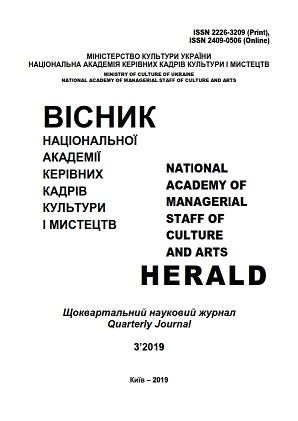Исполнительская стратегия Д. Циффры в организации музыкального времени (на примере фортепианного цикла «Третий год странствий» Ф. Листа)
Performing Strategy by G. Cziffra in the Organization of Musical Space (On the Example Third Volume of F. Liszt‘s “Years of Pilgrimage”)
Author(s): Olesia Aleksandrovna PupinaSubject(s): Music, Recent History (1900 till today), Methodology and research technology, History of Art
Published by: Національна академія керівних кадрів культури і мистецтв
Keywords: time in music art; measure; tempo; rhythm; meter; agogics; interpretation; performing strategies; F. Liszt; G. Cziffra;
Summary/Abstract: The author of the article suggests an approach to the performing interpretation in the context of the music time flow and its implementation by the outstanding pianist of the XX century, G. Cziffra. Purpose of the article is to reveal the individual performing strategies of music time inherent to G. Cziffra (on the example of the third volume of F. Liszt‘s Years of Pilgrimage). Methodology. To achieve this goal, the author uses the methods of comparative, contextual, composition-dramatic and intonational analysis, which are aimed at determining the musician-performer role in understanding (in comprehension of) the author's text through the music material. The scientific novelty of the research is that for the first time in the national musicology, the performing strategy in the music time organization based on a specific example becomes the subject of the scientific research, which makes it possible to identify one of the mastery key parameters in interpreting a composer's music piece. Conclusions. The way the pianist perceives the music time evidently tells us about the indomitable drive towards a goal, the perpetual work of a vibrant consciousness, the continuity of an event-based process formation. G. Cziffra's proclivity for improvisation determines his natural desire to revitalize the performing process, emphasizing its inconstancy, variability. The artist is no longer bound to strictly adhere to the instructions, that is, the necessity to build a rationally-prudent system of performance. The pianist's audacious collaboration, his self-assurance and the undeniability of his intentions, even if his interpretation is mismatched with the composer's remarks, contribute to the unfolding of the yet unknown music meaning facets of the composer's music piece.
Journal: Вісник Національної академії керівних кадрів культури і мистецтв
- Issue Year: 2019
- Issue No: 3
- Page Range: 325-329
- Page Count: 5
- Language: Ukrainian

